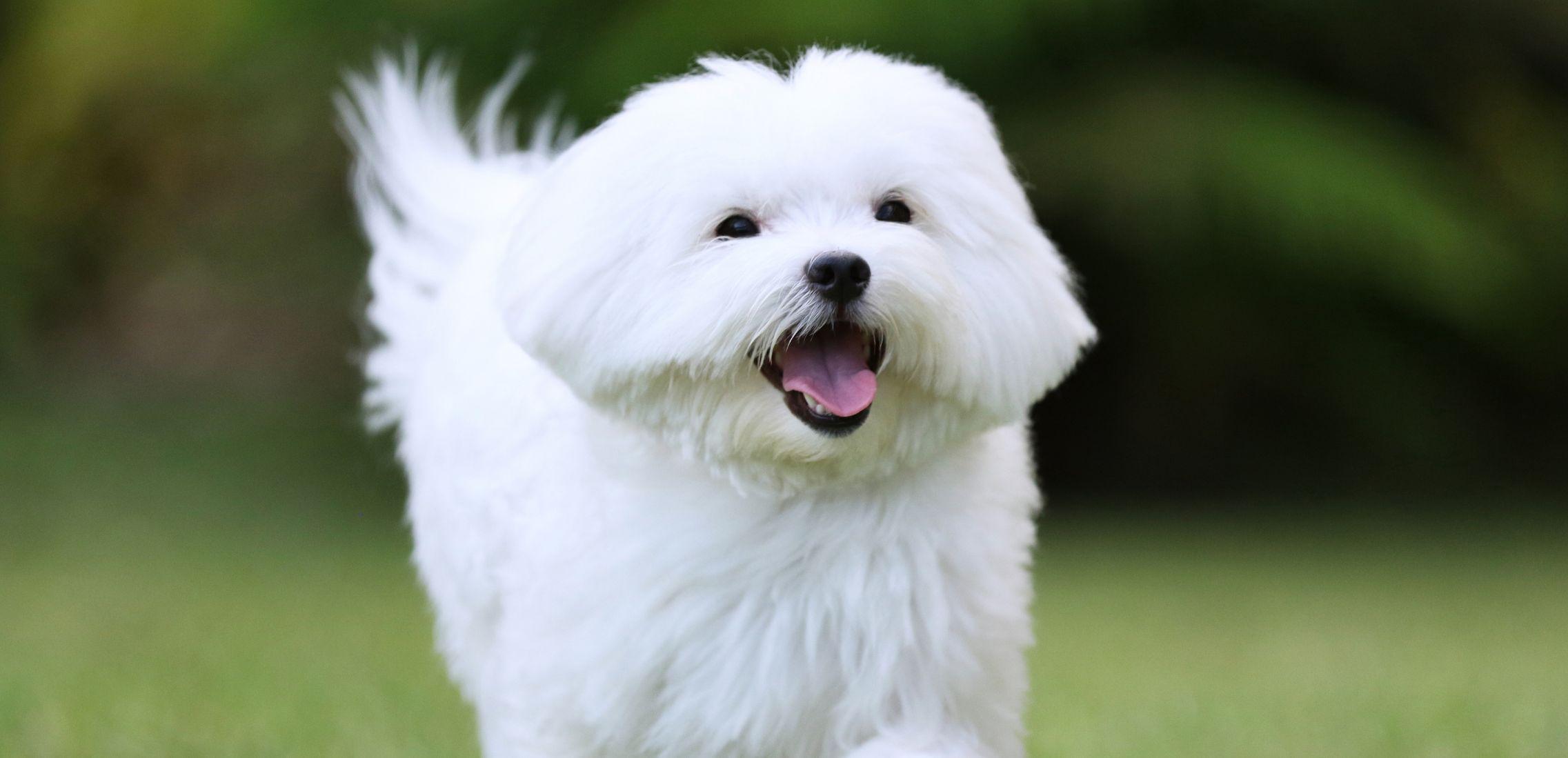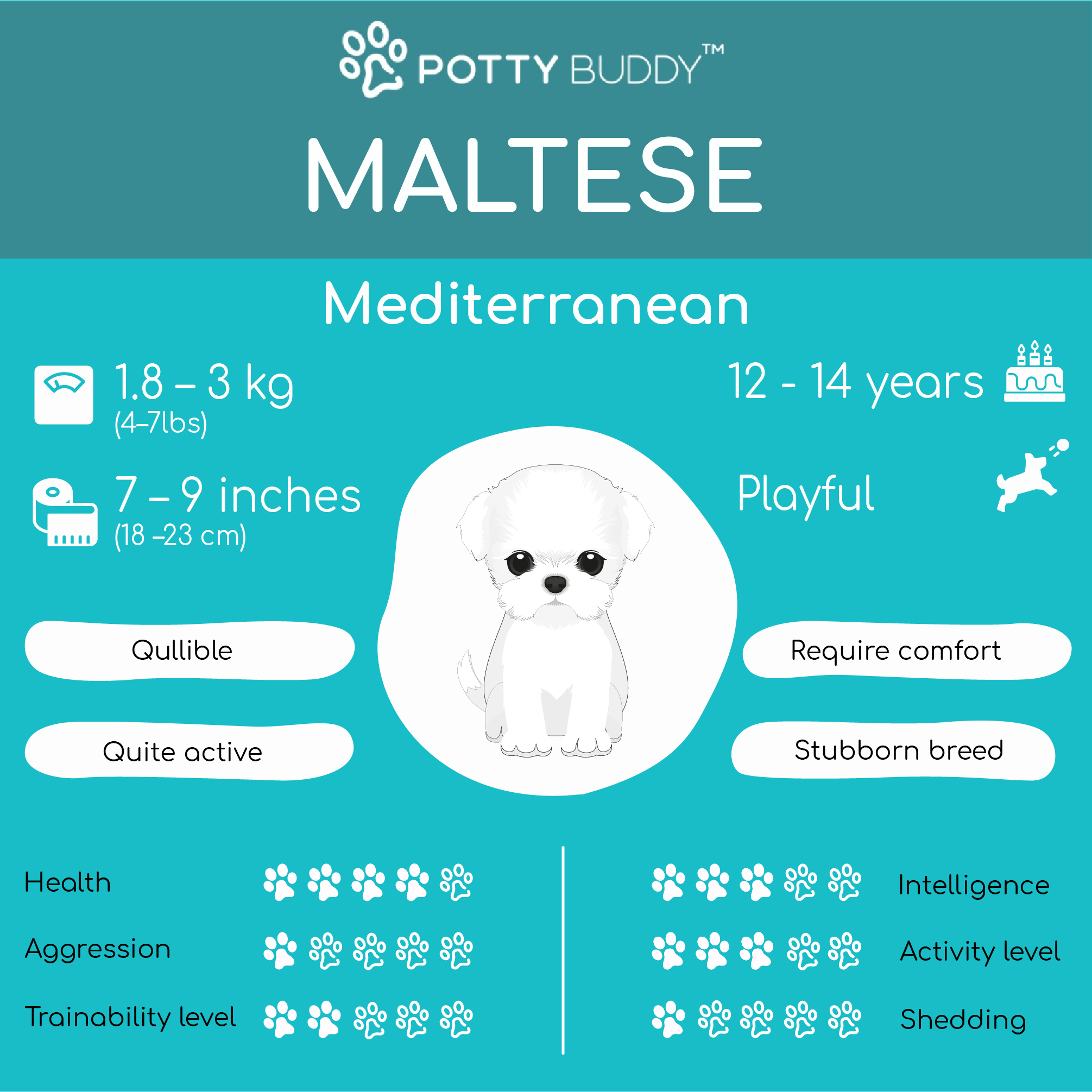Your Cart is Empty
Get Up To 35% OFF & Free Delivery
Get Up To 35% OFF & Free Delivery
Get Up To 35% OFF & Free Delivery

If you’re looking to learn more about the Maltese dog breed, then you’ve come to the right place, as in this dog breed profile we’re going to share everything you need to know about these gorgeous dogs.
The Maltese breed is a popular toy dog known for its elegant and lively personality, not to mention its show-stopping, floor-length coat. Gentle and affectionate in nature, with a keen intelligence, Maltese dogs make an exceptionally responsive and trusting pet.
Whether you're considering adding a Maltese puppy to your family or just want to learn more about this delightful breed, this comprehensive guide covers all the essential information.
From understanding the historical origins of the Maltese to daily care, health issues, and grooming necessities, learn all about what it’s like to live with this charming companion.

Lifespan
12 - 14 years

Size
Small / Toy Breed

Weight
4 - 7 lbs

Height
7 - 9 inches

Colors
Primarily white; some may have shades of light ivory

Size of home
Adapts well to any size home; ideal for apartment living due to their small size

Exercise
Requires moderate exercise; daily short walks (20-30 minutes) and playful activities are sufficient

Grooming
Requires daily brushing to maintain long, silky coat; regular grooming every 4-6 weeks and baths every 3 weeks to keep coat clean and healthy











The Maltese, often referred to as "Ye Ancient Dogge of Malta" or the Maltese Terrier, is a breed renowned for its elegance and aristocratic bearing, a lineage traced back to the lapdogs of ancient Mediterranean cultures. Its radiant white coat and expressive eyes have made the Maltese a symbol of refinement across centuries.
Maltese dogs are known for their affectionate nature and bond deeply with their families, thriving on companionship and closeness. They typically enjoy the company of children who are gentle and respectful of their size and boundaries. This breed's sociable nature often extends to their relationships with other animals, making them excellent companions for homes with multiple pets, provided they are properly introduced.
Despite their petite and delicate appearance, Maltese are surprisingly bold and can be quite spirited. They possess a docile temperament but are not shy about asserting themselves with a spirited bark, especially when greeting new people or in unfamiliar environments.
An interesting part of the Maltese breed's background is its historical name, "Melitae Dog," which points to its rich and noble heritage. For centuries, the Maltese has been a beloved pet, often chosen by royalty and frequently depicted in Renaissance art.
Fun fact:The Maltese has been a muse for poets and artists throughout history, symbolizing purity and love. This breed was so revered in ancient times that it was believed the Maltese had the ability to cure people of disease, earning it a place in the beds of the ailing. Fascinating, hey?
Overall, the Maltese combines a playful and loving disposition with a regal and luxurious appearance, making it not only a devoted pet but also a welcome presence in any home.


The Maltese breed has a history that's as fascinating as its fluffy appearance. Originating from the sunny Mediterranean, specifically around the island of Malta, Maltese have been turning heads and stealing hearts for thousands of years.
Historians believe that the Maltese breed was brought to Malta by the Phoenicians, who were skilled sailors and dominant traders before the Greek Empire emerged. These traders were known for exchanging spices, silks, and other luxury items, including these prized dogs. The Greeks soon caught on to their charm and were so smitten that they immortalized these dogs in their art and philosophy. Even Aristotle is said to praise the Maltese for its perfect proportions, despite its petite size.
But it was the Romans who really took the Maltese to the next level of fame. In Roman high society, having a Maltese trotting by your side was the ultimate accessory—think of it as the ancient version of a designer handbag. These dogs were symbols of status and refinement, with stories of them being gifted to dignitaries and even an emperor or two.
During Europe’s Dark Ages, when many aspects of classical culture were lost, the Maltese breed might have faced extinction if not for the intervention of Chinese kennelers. According to the American Kennel Club (AKC), these breeders crossbred the Maltese with local toy breeds, preserving its lineage and enhancing its features. This refined Maltese was later reintroduced to Europe, where it quickly regained its status as a fashionable accessory among the aristocracy.
Fast forward to the 19th century: the Maltese makes its grand entrance at New York’s first Westminster show in 1877, tagged as the Maltese Lion Dog. It was a showstopper from the start, charming judges and audiences alike. Today, the Maltese continues to be a beloved companion in homes around the globe.


With a compact frame and standing just a few inches tall, the Maltese has a look that mixes elegance with cuteness. Its big, dark eyes and short, neat muzzle give it a face full of expression - like it’s always ready for a selfie!
What really sets the Maltese apart is its stunning, floor-length white coat. Silky and straight, this coat is the breed's crowning glory, often pure white but occasionally with whispers of pale ivory.
Despite its petite size, the Maltese has an exuberant step and carries itself with a confidence that says it knows its royal roots. This delightful combination of charm and grace has captured dog-loving hearts for centuries.
If you’re searching for a more petite dog to join your family, then a Maltese may be the perfect canine companion to consider.
Maltese dogs are famously affectionate and friendly, thriving in the company of their humans. Their favorite spot is often nestled in the laps of their owners, basking in attention and affection. Like a little shadow, they tend to follow their loved ones from one room to another, always eager to be part of the action or simply to offer their companionship.
These small dogs excel in environments where they receive lots of love and care, and they repay this kindness with unwavering loyalty and affection. They are particularly well-suited to families, bringing joy and a gentle presence into the home. Although they are naturally sweet and amiable, like all dogs, they benefit from consistent, positive training from an early age.


Maltese are typically very sociable with other pets, but introductions should be handled carefully. Early socialization plays a critical role in helping them adapt to other animals and prevent any potential anxiety or territorial behavior. Given their small stature, they often do better with pets of a similar or smaller size, as larger animals might intimidate them without proper introduction and positive interactions.
Furthermore, while Maltese are not generally known for a strong prey drive, their interactions with much smaller pets like rodents or birds should be supervised. Early and ongoing training, along with proper socialization, can help a Maltese live harmoniously within a multi-pet household.
All in all, the Maltese is a pleasant companion: incredibly affectionate, easy to bond with, and capable of getting along well with other pets when properly socialized. Their adaptability and loving nature make them a fantastic choice for a family pet.
Training your Maltese can be a joyful journey filled with laughs and learning. These adorable little dogs are eager to please and thrive on positive reinforcement. A well-timed treat or a cheerful praise can work wonders, turning a training session into their favorite part of the day.
However, don't let their angelic looks fool you; Maltese can be quite the clever negotiators. Sometimes they may try to use their adorable antics to get out of following commands, especially when they find something more interesting to do. Consistency and a bit of firmness can help guide them back on track without dampening their spirited personality.
Patience is key, particularly with trickier tasks like potty training, where this breed might need a few extra rounds to master the routine. But stick with it - your Maltese is more than capable of catching on with your loving guidance.


Kick off training early, especially when it comes to socialization. Introduce your Maltese to new faces, furry friends, and various environments. This early exposure helps shape a confident, well-adjusted adult dog who can handle new experiences with grace.
Make sure your training sessions are short and sweet to keep your Maltese engaged. About 10-15 minutes of focused training time is perfect. This breed may love to learn, but they appreciate quick learning bursts even more. Use clear commands and stay consistent with your signals to build a strong communication bridge between you and your pet.
By mixing lots of affection with smart strategies, training your Maltese not only strengthens your bond but also leads to a well-mannered and joyful four-legged friend.
Known for their striking, silky white fur, Maltese require regular grooming to prevent their luxurious coats from matting and collecting dirt.
A daily brushing ritual can turn into a bonding session with your Maltese, who will adore the attention and the pampering. Use a soft-bristled brush to gently comb through their fur, which not only keeps their coat smooth but also distributes natural oils evenly, giving that characteristic Maltese shimmer.
Bathe your Maltese every three weeks - or more frequently if they've turned a play session into a mud bath! Regular baths help keep their coat clean and reduce the risk of skin irritations. Always use a dog-specific shampoo to maintain the health and luster of their fur.


Don't overlook those expressive eyes and perky ears. Maltese are prone to tear staining, so wiping around their eyes gently with a soft, damp cloth can prevent discoloration and keep them looking bright-eyed. Regular ear checks are also crucial to prevent infections, especially since their long fur can trap dirt and moisture.
Nail care is another essential aspect of their grooming routine. Trim their nails every few weeks to prevent discomfort and mobility issues. If you hear their nails clicking on the floor, it's time for a trim.
Dental hygiene rounds out the Maltese care regimen. Frequent teeth brushing with a canine toothpaste will keep bad breath at bay and prevent dental diseases, which are common in smaller breeds.
For those who find the grooming regimen daunting, a professional groomer can be a lifesaver. Scheduling a visit every 4-6 weeks not only keeps your Maltese looking pristine but also provides a professional once-over to catch any potential health issues early.
The Maltese, like any breed, has its own set of health concerns that potential and current owners should be aware of.
Dental Issues:Due to their small mouths, Maltese are particularly susceptible to dental problems. Crowded teeth can lead to a buildup of tartar and plaque, which, if not managed through regular dental care, can result in gum disease and tooth loss. Regular brushing and veterinary cleanings are crucial for maintaining dental health.
Luxating Patella: This common condition in small breeds involves the slipping of the kneecap out of its normal position. Ouch! Signs may include skipping steps or a sudden lift of a hind leg while walking. Treatment varies from managing pain with medication to surgical interventions in severe cases.


Hypoglycemia: Particularly in smaller and younger Maltese, low blood sugar can be a concern. Symptoms might include weakness, lethargy, and in severe cases, seizures. Regular feeding schedules and monitoring are important, especially for puppies or very active dogs.
Heart Issues:Maltese can be prone to various heart conditions, including congestive heart failure, often marked by coughing, fatigue, and difficulty breathing. Regular check-ups can catch these conditions early, and treatments can range from lifestyle changes to medication.
White Shaker Syndrome: This neurological disorder is seen in small, white dogs, including the Maltese. It causes tremors and lack of coordination. While it might look alarming, it is typically manageable with medication.
Early detection and treatment can greatly improve the quality of life for your Maltese, allowing them to lead a happy and healthy life by your side.
As with any canine companion you invite into your life, you may wish to consider pet insurance to help support you with any potential health conditions your Maltese experiences in the future. After all, it’s better to be prepared than landed with a hefty unexpected vets bill!
When selecting a Maltese puppy, thorough research is your first step. Whether you plan to adopt or purchase from a breeder, it's important to understand the health background of the puppy, including any potential hereditary conditions.
Choosing a reputable breeder is key if you decide to buy. A good breeder will be transparent about the health of the puppies and their lineage. They should provide health clearances for the puppy's parents and allow you to visit their facility. This visit not only lets you assess the conditions in which the puppies are raised but also provides a chance to observe the puppy's behavior and temperament firsthand.
Seeing a puppy in person is invaluable. It allows you to connect with the puppy and gauge whether there's an immediate bond, which is essential since this pup will become a part of your family. You'll get a sense of their personality and see if they're drawn to you, helping you decide if they're the right fit for your home and lifestyle.


The cost of a Maltese puppy in 2025 can vary widely depending on several factors, including the breeder's reputation and the puppy's lineage. On average, you might expect to pay anywhere from $600 to $2,000 for a Maltese puppy. Prices can escalate significantly, however, reaching up to $3,000 or more for a puppy from a distinguished breeder.
It’s important to remember that the initial purchase price is just the beginning. Owning a puppy comes with additional financial responsibilities including vaccinations, spaying or neutering, regular vet check-ups, grooming, and essential supplies like a bed, crate, food and toys. This makes getting a Maltese - or any dog - a significant long-term commitment, both emotionally and financially.
Before making this decision, ensure you are prepared for the ongoing care and love needed to raise a happy, healthy Maltese.
If you enjoyed reading about the Maltese dog breed, we’d recommend checking out our other breed profiles. Especially if you’re considering purchasing or adopting a dog in the near future, if a Maltese doesn’t seem like the perfect fit a Pomeranian or a Shih Tzu may just be!

See How Dog Owners Are Using These Leak-Free Potty Pads to Keep Their Homes Clean and Pups Happy
4.7 ⭐⭐⭐⭐⭐
Over 100,000 Dog Owners Saved Money With Potty Buddy™
The washable pee pads that absorb anything your dog throws at them, while keeping your floors and furniture stain-free.
✅ Super Absorbent and Leak-Proof
✅ Great for Potty Training
✅ Ideal for Puppies and Older Dogs
✅ Washable and Reusable For Years
✅ Save over $400/year by not buying disposables
-60 Day Money Back Guarantee-

⭐⭐⭐⭐⭐
-Diana D.
These pads are a life saver for my kitchen floor and bedroom carpet! Just ordered 2 more!




Follow Us On
Check Out Our Most Popular Content